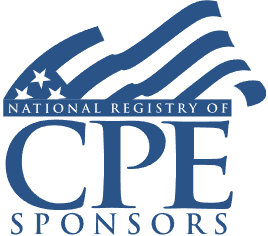Form 1041 Schedule D: Reporting Capital Gains for Trusts and Estates
Beneficiary Allocations, Loss Limitations, DNI, Tax Computation Using Maximum Capital Gains Rates, and More

Course Details
- smart_display Format
On-Demand
- signal_cellular_alt Difficulty Level
Intermediate
- work Practice Area
Tax Preparer
- event Date
Wednesday, April 23, 2025
- schedule Time
1:00 p.m. ET./10:00 a.m. PT
- timer Program Length
110 minutes
-
BARBRI is a NASBA CPE sponsor and this 110-minute webinar is accredited for 2.0 CPE credits.
-
BARBRI is an IRS-approved continuing education provider offering certified courses for Enrolled Agents (EA) and Tax Return Preparers (RTRP).
This course will provide tax advisers with a thorough and practical guide to reporting trust capital gains income on Schedule D of Form 1041. The panel will demonstrate calculating and allocating capital gains and losses to beneficiaries, explain the distributable net income (DNI) rules of IRC 643(a), and discuss the treatment of excess deductions upon an estate or trust's termination. The webinar will also address basis consistency reporting, split-interest trust allocations, and particular Form 8949 issues.
Faculty

Mr. Bridgers' practice encompasses all areas of private wealth and family business. In addition to estate planning and estate administration, he is experienced in mergers and acquisitions, taxation, business transactions, franchising, commercial contracts, asset protection, executive compensation, employee benefits, qualified and non-qualified retirement plans, and nonprofit organizations. He counsels closely-held and family businesses, and nonprofit organizations, with their planning, succession, and liquidity needs in a variety of industries including tech, restaurant and retail, healthcare, manufacturing, construction, real estate, financial services, consulting, and professional staffing.

Mr. Edmondson practices in partnership, corporate, and individual tax planning; business transactions including mergers and acquisitions; business planning; tax controversy; estate and wealth transfer planning; probate; estate and trust litigation; asset protection; and charitable planning. He has conducted, authored, and directed numerous seminars for professional, academic, and civic groups on taxation, business, asset protection and estate planning. Mr. Edmondson works closely with clients to develop and implement such strategies.

Mr. Jones's practice deals with a broad range of expatriate tax, international tax, 1031 exchange and similar issues for clients.
Description
One of the most complex challenges tax advisers face in completing Form 1041 is calculating, allocating, and reporting trust and estate capital gains on Schedule D. Capital gains reporting for trusts and estates contains complicated provisions not found in disclosures for individuals, which make completing the schedule difficult and time-consuming.
In addition to the task of reconciling capital gains statements and computing net investment income, compliance professionals serving fiduciary clients must also contend with intricate DNI considerations in determining what portion of the trust or estate's capital gains to allocate to beneficiaries. In many cases, the trust document is unclear on capital gains inclusion in DNI, so trust advisers must be able to interpret the trust agreement to determine what portion of gains is subject to maximum capital gains rates.
Additionally, since capital losses are not deductible to the beneficiaries until the trust terminates, tax advisers must pay close attention to the loss limitation reporting on Part IV of Schedule D to ensure that unused losses are correctly reported and carried forward. Allocating gains and losses to the trust or estate as opposed to beneficiaries can often be complicated due to provisions in the operating documents.
Listen as our experienced panel of tax advisers provides a thorough and practical guide to Schedule D Capital Gain and Loss reporting for Trusts and Estates Form 1041.
Outline
- Calculating capital gains and losses
- Allocating gains and losses between trust/estate and beneficiaries (Part III)
- Capital loss limitation (Part IV)
- Tax computation using maximum capital gains rates (Part V)
- Navigating basis consistency rules
- Reporting capital gains for split-interest trusts on Form 5227
Benefits
The panel will discuss these and other important topics in this webinar:
- Under what circumstances may capital gains be included in DNI, and how does DNI inclusion impact Schedule D reporting?
- Line-by-line guidance to completing Schedule D
- Calculating maximum capital gains rates for Part IV of Schedule D
- Capital loss limitations and carryforwards to beneficiaries
NASBA Details
Learning Objectives
After completing this course, you will be able to:
- Identify DNI considerations in calculating the tax on trust/estate capital gains
- Determine the impact of basis consistency reporting rules on calculating capital gains in Part I of Schedule D
- Recognize challenges in allocating capital gains and losses between trust/estate and beneficiaries in Part III
- Field of Study: Taxes
- Level of Knowledge: Intermediate
- Advance Preparation: None
- Teaching Method: Seminar/Lecture
- Delivery Method: Group-Internet (via computer)
- Attendance Monitoring Method: Attendance is monitored electronically via a participant's PIN and through a series of attendance verification prompts displayed throughout the program
- Prerequisite: Three years+ business or public firm experience at mid-level within the organization, preparing complex tax forms and schedules, supervising other preparers/accountants. Specific knowledge and understanding of trust income principles, trust agreements and wills; familiarity with concepts of distributable net income, capital gains calculations and split-interest trust definitions and activities reported on Form 5227.

Strafford Publications, Inc. is registered with the National Association of State Boards of Accountancy (NASBA) as a sponsor of continuing professional education on the National Registry of CPE Sponsors. State boards of Accountancy have final authority on the acceptance of individual courses for CPE Credits. Complaints regarding registered sponsons may be submitted to NASBA through its website: www.nasbaregistry.org.

Strafford is an IRS-approved continuing education provider offering certified courses for Enrolled Agents (EA) and Tax Return Preparers (RTRP).
Related Courses

Form 1041 Schedule D: Reporting Capital Gains for Trusts and Estates
Available On-Demand

Closer Connection Exception: Determining Tax Home; Treaty Tie-Breakers, Form 8840
Thursday, April 10, 2025
1:00 PM E.T.
Recommended Resources
How CPE Can Bridge the Gap Between What You Know and What You Need to Know
- Career Advancement